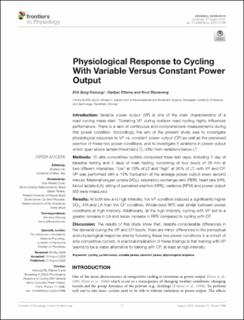| dc.contributor.author | Kolsung, Erik Borg | |
| dc.contributor.author | Ettema, Gertjan | |
| dc.contributor.author | Skovereng, Knut | |
| dc.date.accessioned | 2021-01-22T15:02:38Z | |
| dc.date.available | 2021-01-22T15:02:38Z | |
| dc.date.created | 2021-01-20T22:28:41Z | |
| dc.date.issued | 2020 | |
| dc.identifier.citation | Frontiers in Physiology. 2020, 11, . | en_US |
| dc.identifier.issn | 1664-042X | |
| dc.identifier.uri | https://hdl.handle.net/11250/2724333 | |
| dc.description.abstract | Introduction: Variable power output (VP) is one of the main characteristics of a road cycling mass-start. Tolerating VP during outdoor road cycling highly influences performance. There is a lack of continuous and comprehensive measurements during this power condition. Accordingly, the aim of the present study was to investigate physiological response to VP vs. constant power output (CP) as well as the perceived exertion of these two power conditions, and to investigate if variations in power output which span above lactate threshold (LT), differ from variations below LT.
Methods: 15 elite competitive cyclists completed three test days, including 1 day of baseline testing and 2 days of main testing, consisting of four bouts of 28 min at two different intensities, “low” at 70% of LT and “high” at 95% of LT, with VP and CP. VP was performed with a 15% fluctuation of the average power output every second minute. Maximal oxygen uptake (VO2), respiratory exchange ratio (RER), heart rate (HR), blood lactate (LA), rating of perceived exertion (RPE), cadence (RPM) and power output (W) were measured.
Results: At both low and high intensity, the VP condition induced a significantly higher VO2, HR and LA than the CP condition. Whole-bout RPE was similar between power conditions at high intensity. Additionally, at the high intensity, cycling with VP led to a greater increase in LA and lesser increase in RPE compared to cycling with CP.
Discussion: The results of this study show that, despite considerable differences in the demand during the VP and CP bouts, there are minor differences in the perceptual and physiological response directly following these two power conditions in a cohort of elite competitive cyclists. A practical implication of these findings is that training with VP seems to be a viable alternative to training with CP, at least at high intensity. | en_US |
| dc.language.iso | eng | en_US |
| dc.publisher | Frontiers Media | en_US |
| dc.rights | Navngivelse 4.0 Internasjonal | * |
| dc.rights.uri | http://creativecommons.org/licenses/by/4.0/deed.no | * |
| dc.title | Physiological Response to Cycling With Variable Versus Constant Power Output | en_US |
| dc.type | Peer reviewed | en_US |
| dc.type | Journal article | en_US |
| dc.description.version | publishedVersion | en_US |
| dc.source.volume | 11 | en_US |
| dc.source.journal | Frontiers in Physiology | en_US |
| dc.identifier.doi | https://doi.org/10.3389/fphys.2020.01098 | |
| dc.identifier.cristin | 1876117 | |
| dc.description.localcode | Copyright © 2020 Kolsung, Ettema and Skovereng. This is an open-access article distributed under the terms of the Creative Commons Attribution License (CC BY). The use, distribution or reproduction in other forums is permitted, provided the original author(s) and the copyright owner(s) are credited and that the original publication in this journal is cited, in accordance with accepted academic practice. No use, distribution or reproduction is permitted which does not comply with these terms. | en_US |
| dc.source.articlenumber | 1098 | en_US |
| cristin.ispublished | true | |
| cristin.fulltext | original | |
| cristin.qualitycode | 1 | |

